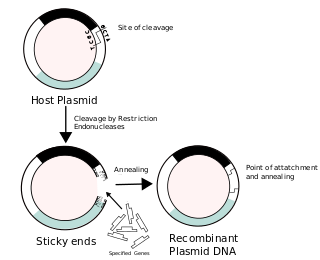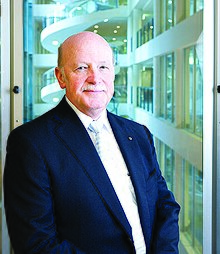
The University of California, San Francisco (UCSF) is a public land-grant research university in San Francisco, California. It is part of the University of California system and it is dedicated entirely to health science. It is a major center of medical and biological research and teaching.

Leroy "Lee" Edward Hood is an American biologist who has served on the faculties at the California Institute of Technology (Caltech) and the University of Washington. Hood has developed ground-breaking scientific instruments which made possible major advances in the biological sciences and the medical sciences. These include the first gas phase protein sequencer (1982), for determining the sequence of amino acids in a given protein; a DNA synthesizer (1983), to synthesize short sections of DNA; a peptide synthesizer (1984), to combine amino acids into longer peptides and short proteins; the first automated DNA sequencer (1986), to identify the order of nucleotides in DNA; ink-jet oligonucleotide technology for synthesizing DNA and nanostring technology for analyzing single molecules of DNA and RNA.

Herbert Wayne "Herb" Boyer is an American Biotechnologist, researcher and entrepreneur in biotechnology. Along with Stanley N. Cohen and Paul Berg he discovered a method to coax bacteria into producing foreign proteins, thereby jump starting the field of genetic engineering. By 1969, he performed studies on a couple of restriction enzymes of the E.coli bacterium with especially useful properties. He is recipient of the 1990 National Medal of Science, co-recipient of the 1996 Lemelson–MIT Prize, and a co-founder of Genentech. He was professor at the University of California, San Francisco (UCSF) and later served as vice president of Genentech from 1976 until his retirement in 1991.
The Shine–Dalgarno (SD) sequence is a ribosomal binding site in bacterial and archaeal messenger RNA, generally located around 8 bases upstream of the start codon AUG. The RNA sequence helps recruit the ribosome to the messenger RNA (mRNA) to initiate protein synthesis by aligning the ribosome with the start codon. Once recruited, tRNA may add amino acids in sequence as dictated by the codons, moving downstream from the translational start site.

Recombinant DNA (rDNA) molecules are DNA molecules formed by laboratory methods of genetic recombination that bring together genetic material from multiple sources, creating sequences that would not otherwise be found in the genome.
Tom Maniatis, is an American professor of molecular and cellular biology. He is a Professor at Columbia University, and serves as the Scientific Director and CEO of the New York Genome Center.
Expression cloning is a technique in DNA cloning that uses expression vectors to generate a library of clones, with each clone expressing one protein. This expression library is then screened for the property of interest and clones of interest are recovered for further analysis. An example would be using an expression library to isolate genes that could confer antibiotic resistance.
A ribosome binding site, or ribosomal binding site (RBS), is a sequence of nucleotides upstream of the start codon of an mRNA transcript that is responsible for the recruitment of a ribosome during the initiation of translation. Mostly, RBS refers to bacterial sequences, although internal ribosome entry sites (IRES) have been described in mRNAs of eukaryotic cells or viruses that infect eukaryotes. Ribosome recruitment in eukaryotes is generally mediated by the 5' cap present on eukaryotic mRNAs.

Joachim Wilhelm "Jo" Messing was a German-American biologist who was a professor of molecular biology and the fourth director of the Waksman Institute of Microbiology at Rutgers University.
Christopher Carl Goodnow is an immunology researcher and the current Executive Director of the Garvan Institute of Medical Research. He holds the Bill and Patricia Ritchie Foundation Chair and is a Conjoint Professor in the Faculty of Medicine at UNSW Sydney. He holds dual Australian and US citizenship.
Alan Ashworth, FRS is a British molecular biologist, noted for his work on genes involved in cancer susceptibility. He is currently the President of the UCSF Helen Diller Family Comprehensive Cancer Center at the University of California, San Francisco, a multidisciplinary research and clinical care organisation that is one of the largest cancer centres in the Western United States. He was previously CEO of the Institute of Cancer Research (ICR) in London.

John Stanley Mattick is an Australian molecular biologist known for his efforts to assign function to non-coding DNA. Mattick was the executive director of the Garvan Institute of Medical Research from 2012 to 2018. He joined Genomics England in May 2018 as Chief Executive Officer. In October 2019, he joined the University of New South Wales in Sydney.

Keith R. Yamamoto is Vice Chancellor for Research, Executive Vice Dean of the School of Medicine, and Professor of Cellular and Molecular Pharmacology at the University of California, San Francisco, UCSF. He is known for his Molecular Biology and Biochemistry research on nuclear receptors and his involvement in science policy.
Keiichi Itakura is an organic chemist and a Professor in the Department of Molecular and Cellular Biology at the Beckman Research Institute at City of Hope National Medical Center.

Frank Gannon is the seventh Director of QIMR Berghofer Medical Research Institute in Brisbane, Australia. He is a molecular biologist and has held high-profile appointments in scientific management and research in Ireland, England, the United States, France, Germany and Australia.
Hugo Alberto Barrera Saldaña is a Mexican biologist, biochemist, researcher, entrepreneur, professor and academic, most noted for being author of several studies on molecular biology, epidemiology, and biomedicine, among which stand out his publications about the Growth Hormone family, human genome sequencing and development of HPV treatment and diagnostic methods.
Professor Susan J. Clark is an Australian biomedical researcher in epigenetics of development and cancer. She was elected a Fellow of the Australian Academy of Science in 2015, and is a National Health and Medical Research Council (NHMRC) Senior Principal Research Fellow and Research Director and Head of Genomics and Epigenetics Division at the Garvan Institute of Medical Research. Clark developed the first method for bisulphite sequencing for DNA methylation analysis and used it to establish that the methylation machinery of mammalian cells is capable of both maintenance and de novo methylation at CpNpG sites and showed is inheritable. Clark's research has advanced understanding of the role of DNA methylation, non-coding RNA and microRNA in embryogenesis, reprogramming, stem cell development and cancer and has led to the identification of epigenomic biomarkers in cancer. Clark is a founding member of the International Human Epigenome Consortium (IHEC) and President of the Australian Epigenetics Alliance (AEpiA).
Lynn Dalgarno is an Australian geneticist known for the discovery of the Shine-Dalgarno sequence with his graduate student, John Shine.
Archaeal translation is the process by which messenger RNA is translated into proteins in archaea. Not much is known on this subject, but on the protein level it seems to resemble eukaryotic translation.

Raymond L. Rodriguez is an American professor of biology, specializing in molecular biology, genomics and biotechnology. His current research interests include diet-genome interactions, plant-made pharmaceuticals and the food/brain axis. Rodriguez is also an inventor, and entrepreneur. His research at the University of California, San Francisco in the 1970’s helped lay the foundation for the biotechnology industry. He also holds several issued US patents. He is involved in programs that promote diversity, equity and inclusion for women and underrepresented minorities in science, technology, engineering, and mathematics (STEM) disciplines.










